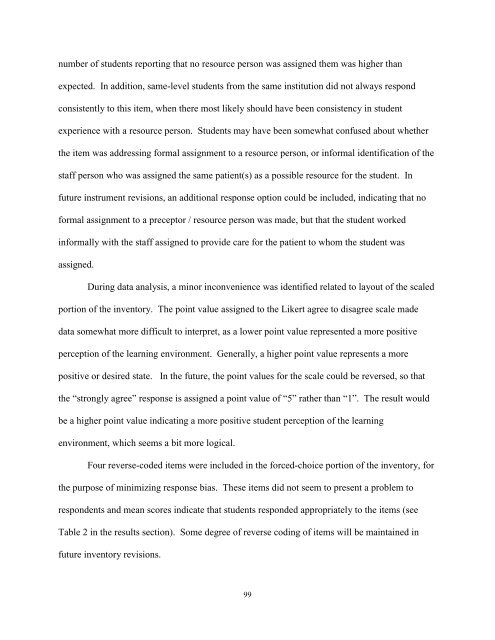STUDENT EVALUATION OF CLINICAL EDUCATION ENVIRONMENT
STUDENT EVALUATION OF CLINICAL EDUCATION ENVIRONMENT
STUDENT EVALUATION OF CLINICAL EDUCATION ENVIRONMENT
Create successful ePaper yourself
Turn your PDF publications into a flip-book with our unique Google optimized e-Paper software.
number of students reporting that no resource person was assigned them was higher than<br />
expected. In addition, same-level students from the same institution did not always respond<br />
consistently to this item, when there most likely should have been consistency in student<br />
experience with a resource person. Students may have been somewhat confused about whether<br />
the item was addressing formal assignment to a resource person, or informal identification of the<br />
staff person who was assigned the same patient(s) as a possible resource for the student. In<br />
future instrument revisions, an additional response option could be included, indicating that no<br />
formal assignment to a preceptor / resource person was made, but that the student worked<br />
informally with the staff assigned to provide care for the patient to whom the student was<br />
assigned.<br />
During data analysis, a minor inconvenience was identified related to layout of the scaled<br />
portion of the inventory. The point value assigned to the Likert agree to disagree scale made<br />
data somewhat more difficult to interpret, as a lower point value represented a more positive<br />
perception of the learning environment. Generally, a higher point value represents a more<br />
positive or desired state. In the future, the point values for the scale could be reversed, so that<br />
the “strongly agree” response is assigned a point value of “5” rather than “1”. The result would<br />
be a higher point value indicating a more positive student perception of the learning<br />
environment, which seems a bit more logical.<br />
Four reverse-coded items were included in the forced-choice portion of the inventory, for<br />
the purpose of minimizing response bias. These items did not seem to present a problem to<br />
respondents and mean scores indicate that students responded appropriately to the items (see<br />
Table 2 in the results section). Some degree of reverse coding of items will be maintained in<br />
future inventory revisions.<br />
99












